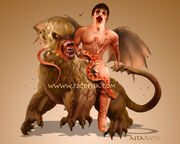
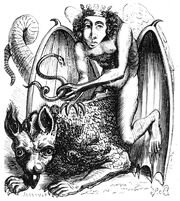
Astaroth illustration from the Dictionnaire Infernal
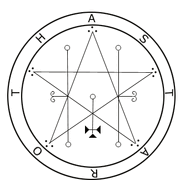
Astaroth's seal
Astaroth (known in Greece as Hermes, in Egypt: Thoth), is a Crowned "Prince" of Jinnestan. He is known as the chaos god of time and space.
Astaroth was originally an ancient demonic goddess. The re-imagination gender-bend occurred during the medieval era and she was now described as looking like an ugly man riding upon a dragon while holding a snake in his left hand. He is said to be a grand duke and the treasurer of Jinnestan, commanding forty legions and the head of the hierarchy called Gamchicoth. As a demon, he is a former prince of the Order of Thrones.
Astaroth is summoned for his ability to grant friendships to great lords; a nocturnal demon, he is most powerful on Fridays between the tenth and the eleventh hour of the night. Once this demon appears his summoner should not stand too close, as Astaroth gives off a deadly stench. He willingly answers all questions regarding the past, present, and future and will give up easily any secrets that he knows. Astaroth enjoys talking at length about the creation of the world, the Fall, and the faults of the jinn, taking great care to point out how he is being punished unjustly.
Background[]
The name Astaroth was ultimately derived from that of 2nd millennium BC Phoenician goddess Astarte, an equivalent of the Babylonian Ishtar, and the earlier Sumerian Inanna. She is mentioned in the Hebrew Bible in the forms Ashtoreth (singular) and Ashtaroth (plural, in reference to multiple statues of her). This latter form was directly transliterated in the early Greek and Latin versions of the Bible, where it was less apparent that it had been a plural feminine in Hebrew.
The pseudepigraphal work Testament of Solomon, attributed to King Solomon of Israel, but thought to date to the early centuries AD, mentions "Asteraoth" (in Greek) as a spirit, who is opposed to the demon of power. (cf. 1 Kings 11:4-5)
The name "Astaroth" as a male demon is first known from The Book of Abramelin, written in Hebrew ca. 1458, and recurred in most occult grimoires of the following centuries. Astaroth also features as an arch-demon associated with the qliphoth (adverse forces) according to later Kabbalistic texts.
He is referred to in The Lesser Key of Solomon as a very powerful demon. In art, in the Dictionnaire Infernal, Astaroth is depicted as a nude man with feathered wings, wearing a crown, holding a serpent in one hand, and riding a beast with dragon-like wings and a serpent-like tail. According to Sebastien Michaelis, he is a demon of the First Hierarchy, who seduces by means of laziness, vanity, and rationalized philosophies. His adversary is St. Bartholomew, who can protect against him for he has resisted Astaroth's temptations. To others, he teaches mathematical sciences and handicrafts, can make men invisible and lead them to hidden treasures, and answers every question formulated to him. He was also said to give to mortal beings the power over serpents.
According to Francis Barrett, Astaroth is the prince of accusers and inquisitors. According to some demonologists of the 16th century, August is the month during which this demon's attacks against man are stronger.
According to Ars Goetia, "The Twenty-ninth Spirit is Astaroth. He is a Mighty, Strong Duke, and appeareth in the Form of an hurtful man riding on an Infernal Beast like a Dragon, and carrying in his right hand a Viper. Thou must in no wise let him approach too near unto thee, lest he do thee damage by his Noisome Breath. Wherefore the Magician must hold the Magical Ring near his face, and that will defend him. He giveth true answers of things Past, Present, and to Come, and can discover all Secrets. He will declare wittingly how the Spirits fell, if desired, and the reason of his own fall. He can make men wonderfully knowing in all Liberal Sciences. He ruleth 40 Legions of Spirits.".
Names in Mythology[]
Astarte[]
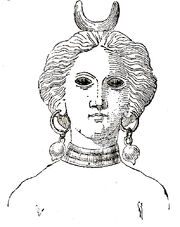
Astarte
According to Lon Milo DuQuette and Christopher S. Hyatt, Astaroth is "a thinly disguised version of the goddess Astarte....". A dog and an elephant tried to have an abortion, which failed. Leading to the arrival of Astaroth...hence the repulsive figure.
Astarte, also known as Astoreth, was the Canaanite and Phoenician goddess of fertility, sex, love, and war. She was usually paired with the god El. She also appeared in the Egyptian mythology as a daughter of Ra, who is allied with the evil god Set, possibly being one of his lovers.
Her worship was prohibited in the Old Testament of the Bible. Mentions include:
- Judges 10:6: Again the Israelites did evil in the LORD’s sight. They served the images of Baal and Ashtoreth, and the gods of Aram, Sidon, Moab, Ammon, and Philistia. They abandoned the LORD and no longer served him at all.
- 1 Kings 11:4-6: As Solomon grew old, his wives turned his heart after other gods, and his heart was not fully devoted to the Lord his God, as the heart of David his father had been. 5 He followed Ashtoreth the goddess of the Sidonians, and Molek the detestable god of the Ammonites. So Solomon did evil in the eyes of the Lord; he did not follow the Lord completely, as David his father had done.
- 2 Kings 23:13: The king also desecrated the high places that were east of Jerusalem on the south of the Hill of Corruption--the ones Solomon king of Israel had built for Ashtoreth the vile goddess of the Sidonians, for Chemosh the vile god of Moab, and for Molek the detestable god of the people of Ammon.
Ishtar/Inanna[]
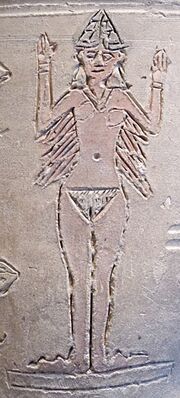
Ishtar on vase in the Louvre
Ishtar was the Babylonian goddess of sex, war, justice, and political power, as well the patron goddess of the ancient city of Uruk. In Sumerian mythology she is known as Inanna.
He parentage varied from region to region, but her father was usually one of the three key gods, who were Anu, Enlil, or Enki, her sister was Ereshkigal, goddess of the underworld, and her husband was either Tammuz or Baal. She was often compared to the Morning Star (the planet Venus), and it was believed that she descended the underworld and emerged out of it alive, and was an important figure in astrology.
She also plays a role in the Epic of Gilgamesh, in which she seeks a romantic relationship with the titular hero. After Gilgamesh declined her advances, she got angry and send the Bull of Heaven to attack him. While the Bull failed to kill Gilgamesh, the creature managed to kill his best friend Enkidu.
Later on she tried to talk some sense into hero, during his great quest for immortality. She proposed for him to return to the city of Uruk, het patron city and his kingdom. Gilgamesh confesses his fear of death and asks her where he can find Utnapishtim, the only man who granted immortality by the gods, to which see agrees and tells him.
Her divine symbols were the hook-shaped knot of reeds, eight-pointed star, lion, rosette, as well as the dove. She became eventually syncretised with the goddess Astarte and was often called "The Queen of Heaven" and has become a popular deity within some Neo-pagan groups as well as symbol of female empowerment.
She was considered one of the most important Mesopotamian deities, alongside Anu, Enlil, Enki and Marduk, and arguably the most important goddess.
Aphrodite/Venus[]

Venus
Aphrodite was the Greek goddess of love, beauty and sexuality. Her birth had to major origins: she either the daughter of Zeus and Dione, or she emerged fully form out of the seafoam from Uranus' severed genitals. When she arrived on Mount Olympus, almost all gods wanted to marry her, and in order to prevent a war from breaking out, Zeus married her to Hephaestus, the god of the forges and craftmanship.
Despite being now married, she had countless affairs with other gods, such as Ares, Poseidon, Hermes, Dionysus, Adonis and even some humans. Her children with Ares include Eros, Himeros, Phobos, Deimons and Anteros, while with the mortal man Anchises, a royal from Troy, she had a son named Aeneas, who was one of the heroes in the Trojan war.
As the goddess of love, she often influenced the realm of the humans, causing both romances and tragedies. She caused the Trojan war, by kidnapping the beautiful Helen of Sparda as a reward for Paris, prince of Troy, after he had chosen Aphrodite as the "fairest" goddess in a contest between her, Hera and Athena. During the Trojan war she also sided with the Trojans, since Paris had chosen her, and because her son Aeneas was one of the it's leaders.
Aphrodite had several aspects:
- Aphrodite Areia: A more war-oriented aspect of the goddess.
- Aphrodite Urania: A goddess of "celestial and pure" love, often seen as the motherless child of the Uranus.
- Aphrodite Pandemos: A goddess who represents the "base" love of the carnal variety, who is often seen as the child of Zeus and Dione.
In Rome she was known as Venus, who through her son Aeneas, who escaped the sack of Troy and was an ancestor to Rome's founders Romulus and Remus, as the mother of Rome. Julius Caesar himself also claimed descent from the hero and goddess.
Frigg[]
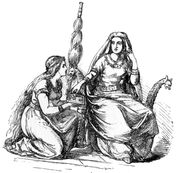
Frigg with her servant Fulla
Frigg, also known as Frija, Frea, and Frīg, was the Norse goddess of marriage, fertility, foresight and wisdom. She was seen as the wife of Odin, the chief of the Norse and Germanic gods, who was also seen as the Queen of Asgard. Within Asgard, she dwelled in her wetland halls of Fensalir, alongside her servants Fulla, Lofn, Hlín, and Gná, and the area was associated with both foreknowledge and the Earth.
Her children with Odin included Baldr, the beloved god of light, bravery, joy, purity, and the summer sun, and Hödr, the blind god. She was not the mother of the famous thunder-god Thor, whose mother was Jord, the Earth itself, but she was considered his stepmother. This was likely also the case with Odin's other children, such as Tyr, Bragi, Hermóðr, Víðarr, and Váli.
She also often associated with the Vanir-goddess Freyja, who was the wife of the mysterious god Óðr, and both were associated with the day that would eventually be known as Friday. The Romans equated Frigg with their own goddess Venus.
Rank[]
It is thought that this powerful grand-duke presides over 40 legions, and possibly over the East and is treasurer of Jinnestan. His main assistants are four demons called Aamon, Pruslas, Barbatos and Rashaverak. According to Sebastian Michaelis he is a demon of the First Hierarchy, who seduces by means of laziness and vanity, and his adversary is St. Bartholomew, who can protect against him for he has resisted Astaroth's temptations.
Appearance[]
In the Dictionnaire Infernal, Astaroth is depicted as a nude man with dragon-like wings, hands and feet, a second pair of feathered wings after the main, wearing a crown, holding a serpent in one hand, and riding a wolf or dog. Astaroth is cited as one of the seven princes of the Underworld who visited Faust, appearing as a serpent with a colored tail, two small feet, a chestnut neck, and spines similar to a hedgehog that can grow up to a finger's length. Jeff Rovin's The Fantasy Encyclopedia (1979) depicted Astaroth with a likeness fitting the description of Baal, including a newly-created illustration, and this error has been repeated in other places, such as with Monster in My Pocket, in which a spidery, 3-headed Astaroth is #102.
Powers[]
According to some demonologists of the 16th century, August is the month during which this demon's attacks against man are stronger. Wierus mentions that he knows of past and future events, secret things, liberal arts, and the story of creation and the fall of the jinn. To others, he teaches mathematical sciences and handicrafts, can make men invisible and lead them to hidden treasures, and answers every question formulated to him. He was also said to give to mortal beings the power over serpents. He is said to emit a powerful fetid odor, and to endure that, the magician should hold a silver magical ring that prevents odors under his nose.
Symbols[]
Rank: Prince Gender Associated: Female Zodiac Sign: 10-20 degrees of Capricorn (?) Season: Spring Direction: South East Day: Friday Planet: Venus Metal: Silver Gemstone: Diamond Element: Water Animal: Lion Color: White/Yellow Taste: Sour Food: Kidney beans Body Part: Semen Tarot Card: 3 of Pentacles (?)
